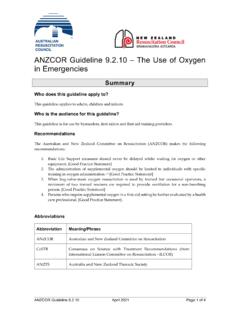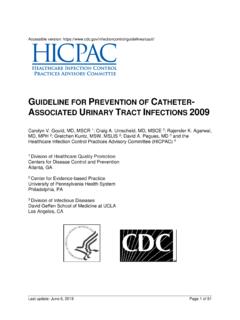Transcription of ARC Guideline 11.1 Introduction to and Principles of In ...
1 ARC Guideline Introduction to and Principles of In- hospital Resuscitation Summary This Guideline focuses on in- hospital resuscitation and provides background information on BLS and ALS appropriate for the in- hospital environment. It should be read in conjunction with BLS, ALS and Paediatric guidelines. Who does this Guideline apply to? This Guideline applies to adults and children who require advanced life support (ALS) in an in- hospital environment. Who is the audience for this Guideline ? This Guideline is for health care professionals in hospital environments where equipment and medications are available. Recommendations The Australian Resuscitation Council (ARC) recommends that: 1. As soon as possible, Advanced Life Support treatments are used to supplement the care of any patient receiving Basic Life Support.
2 2. Hospitals use early warning, rapid response team, or medical emergency team systems to reduce the incidence of in- hospital cardiac arrests, and in- hospital mortality, and to treat patient deterioration. 3. Hospitals use a system validated for their specific patient population to identify individuals at increased risk of serious clinical deterioration, cardiac arrest, or death, both on admission to hospital and during their stay. Systems should ensure: clinical deterioration is recognised early to prevent cardiac arrest;. cardiorespiratory arrest is recognised immediately;. help is summoned using a specific telephone number/call system;. CPR is started immediately and, if indicated, defibrillation is attempted as soon as possible (ideally within 3 min).
3 ARC Guideline February 2019 Page 1 of 22. Guideline Guideline Process This Guideline updates Guideline , incorporates the previous Guideline Cardiopulmonary Resuscitation for Advanced Life Support Providers, and includes new material related to in- hospital resuscitation partly based on the Resuscitation Council (UK). In- hospital resuscitation This Guideline includes evidence from the 2015 ILCOR. review process using grade methodology and the NHMRC methodology used in the previous Guideline The Guideline process includes involvement of stakeholders from all member organisations of the ARC, and peer review by the Australian Resuscitation Council and their Executive Committee. Details of the guidelines development process can be found on the ARC website Summary of changes Combines previous Guidelines and with the addition of further information on Principles of in- hospital resuscitation.
4 Introduction This Guideline is aimed primarily at health care professionals who are likely to be the first to respond to an in- hospital cardiac arrest or significant clinical deterioration. It may also be applicable to healthcare professionals working in other clinical settings. The ARC document Standards for Resuscitation: Clinical Practice and Education supports the implementation of this Guideline . Except where specified, the advice is the same for infants (other than newborns) and children as it is for adults. Prevention of Cardiac Arrest Children and young adults presenting with characteristic symptoms of arrhythmic syncope should have a specialist cardiology assessment, which should include an ECG and in most cases an echocardiogram and exercise [Class A, Expert consensus opinion].
5 Characteristics of arrhythmic syncope include: syncope in the supine position, occurring during or after exercise, with no or only brief prodromal symptoms, repetitive episodes, or in individuals with a family history of sudden cardiac death (SCD). In addition, non-pleuritic chest pain, palpitations associated with syncope, seizures (when resistant to treatment, or occurring at night) should raise suspicion of increased risk of arrhythmic syncope. Systematic evaluation in a clinic specialising in the care of those at risk for SCD is recommended in family members of young victims of SCD or those with a known cardiac disorder resulting in an increased risk of [Class B; Expert consensus opinion]. In- hospital Pre-Arrest Detection and Management In adult patients admitted to hospital , there is variable evidence regarding the use of early warning systems/rapid response team (RRT) systems or medical emergency team (MET).
6 ARC Guideline February 2019 Page 2 of 22. systems (compared with no such systems) to reduce cardiac and respiratory arrests and hospital ARC suggests that hospitals consider the Introduction of an early warning score EWS/response team/MET system to reduce the incidence of in- hospital cardiac arrests (IHCA). and in- hospital mortality (CoSTR 2015 weak recommendation, low-quality evidence).3 It is reasonable, and increasingly mandated by health authorities, that hospitals provide a system of care that includes2,4 : staff education about the signs of patient deterioration;. appropriate and regular vital signs monitoring of patients;. clear guidance ( via calling criteria or early warning scores) to assist staff in the early detection of patient deterioration.
7 A clear, uniform system of calling for assistance, and;. a clinical response to calls for assistance. [Class A; Expert consensus opinion]. There is insufficient evidence to identify the best methods for the delivery of these components, and on current evidence, this should be based on local circumstances. 2, 4 [Class A; Expert consensus opinion] Hospitals should use a system validated for their specific patient population to identify individuals at increased risk of serious clinical deterioration, cardiac arrest, or death, both on admission and during hospital [Class A; Expert consensus opinion]. There is insufficient evidence to identify specific educational strategies that improve outcomes ( early recognition and rescue of deteriorating patient at risk of cardiac/respiratory arrest).
8 Educational efforts have a positive impact on knowledge, skills, attitudes and confidence, and increase the frequency of activation of a response and should therefore be [Class A; Expert consensus opinion]. The importance of BLS. BLS is only a temporary measure to maintain ventilation and circulation. Effective chest compression provides a cardiac output of only 20-30% of the pre-arrest value 5, and rescue breathing without supplemental oxygen provides ventilation with an inspired oxygen concentration of only 15%.2,6 Electrical defibrillation is the mainstay of treatment for ventricular fibrillation and pulseless VT. The chance of successful defibrillation decreases with time. Therefore high quality CPR and decreasing the time to defibrillation are the first priorities in resuscitation from cardiac arrest.
9 The purpose of BLS is to help maintain myocardial and cerebral oxygenation until ALS personnel and equipment are available: effective BLS may increase the likelihood of successful defibrillation. 7. effective BLS buys time until reversible causes can be diagnosed and/or treated. Monitoring CPR quality and resuscitation performance is an important element of Basic and Advanced Life Support and includes: effectiveness of compressions (adequacy of depth, rate and minimising hands off periods);. adequacy of ventilation (avoiding over-ventilation and consequent deleterious effects);. timing of defibrillation with regard to likelihood of success (as soon as possible and providing compressions before and after). ARC Guideline February 2019 Page 3 of 22.
10 Patient care during the pre-arrest period (early detection and prevention of cardiac arrest). and the post-resuscitation management are also vital to improving patient outcomes. An extensive review of many aspects of advanced life support was performed as part of the 2010 and 2015 Consensus on Science The information from this process has been incorporated into the guidelines wherever appropriate. After in- hospital cardiac arrest the division between Basic Life Support (BLS) and Advanced Life Support (ALS) is arbitrary; in practice, the resuscitation process is a continuum but BLS. and ALS are specifically defined in the ARC Glossary. For all in- hospital cardiac arrests, ensure: cardiorespiratory arrest is recognised immediately;. help is summoned using a specific telephone number/call system.





